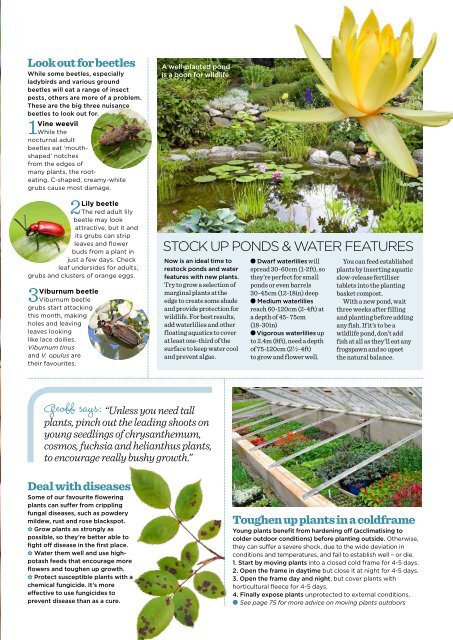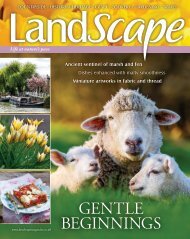Garden Answers Mini-Mag
Get a taste of the lovely Garden Answers magazine with this free sampler!
Get a taste of the lovely Garden Answers magazine with this free sampler!
Create successful ePaper yourself
Turn your PDF publications into a flip-book with our unique Google optimized e-Paper software.
Look out for beetles<br />
While some beetles, especially<br />
ladybirds and various ground<br />
beetles will eat a range of insect<br />
pests, others are more of a problem.<br />
These are the big three nuisance<br />
beetles to look out for.<br />
Vine weevil<br />
1 While the<br />
nocturnal adult<br />
beetles eat ‘mouthshaped’<br />
notches<br />
from the edges of<br />
many plants, the rooteating,<br />
C-shaped, creamy-white<br />
grubs cause most damage.<br />
2Lily beetle<br />
The red adult lily<br />
beetle may look<br />
attractive, but it and<br />
its grubs can strip<br />
leaves and flower<br />
buds from a plant in<br />
just a few days. Check<br />
leaf undersides for adults,<br />
grubs and clusters of orange eggs.<br />
3Viburnum beetle<br />
Viburnum beetle<br />
grubs start attacking<br />
this month, making<br />
holes and leaving<br />
leaves looking<br />
like lace doilies.<br />
Viburnum tinus<br />
and V. opulus are<br />
their favourites.<br />
A well-planted pond<br />
is a boon for wildlife<br />
STOCK UP PONDS & WATER FEATURES<br />
Now is an ideal time to<br />
restock ponds and water<br />
features with new plants.<br />
Try to grow a selection of<br />
marginal plants at the<br />
edge to create some shade<br />
and provide protection for<br />
wildlife. For best results,<br />
add waterlilies and other<br />
floating aquatics to cover<br />
at least one-third of the<br />
surface to keep water cool<br />
and prevent algae.<br />
l Dwarf waterlilies will<br />
spread 30-60cm (1-2ft), so<br />
they’re perfect for small<br />
ponds or even barrels<br />
30-45cm (12-18in) deep<br />
l Medium waterlilies<br />
reach 60-120cm (2-4ft) at<br />
a depth of 45- 75cm<br />
(18-30in)<br />
l Vigorous waterlilies up<br />
to 2.4m (8ft), need a depth<br />
of 75-120cm (2½-4ft)<br />
to grow and flower well.<br />
You can feed established<br />
plants by inserting aquatic<br />
slow-release fertiliser<br />
tablets into the planting<br />
basket compost.<br />
With a new pond, wait<br />
three weeks after filling<br />
and planting before adding<br />
any fish. If it’s to be a<br />
wildlife pond, don’t add<br />
fish at all as they’ll eat any<br />
frogspawn and so upset<br />
the natural balance.<br />
Geoff says: “Unless you need tall<br />
plants, pinch out the leading shoots on<br />
young seedlings of chrysanthemum,<br />
cosmos, fuchsia and helianthus plants,<br />
to encourage really bushy growth.”<br />
Deal with diseases<br />
Some of our favourite flowering<br />
plants can suffer from crippling<br />
fungal diseases, such as powdery<br />
mildew, rust and rose blackspot.<br />
✿ Grow plants as strongly as<br />
possible, so they’re better able to<br />
fight off disease in the first place.<br />
✿ Water them well and use highpotash<br />
feeds that encourage more<br />
flowers and toughen up growth.<br />
✿ Protect susceptible plants with a<br />
chemical fungicide. It’s more<br />
effective to use fungicides to<br />
prevent disease than as a cure.<br />
Toughen up plants in a coldframe<br />
Young plants benefit from hardening off (acclimatising to<br />
colder outdoor conditions) before planting outside. Otherwise,<br />
they can suffer a severe shock, due to the wide deviation in<br />
conditions and temperatures, and fail to establish well – or die.<br />
1. Start by moving plants into a closed cold frame for 4-5 days.<br />
2. Open the frame in daytime but close it at night for 4-5 days.<br />
3. Open the frame day and night, but cover plants with<br />
horticultural fleece for 4-5 days.<br />
4. Finally expose plants unprotected to external conditions.<br />
l See page 75 for more advice on moving plants outdoors

















